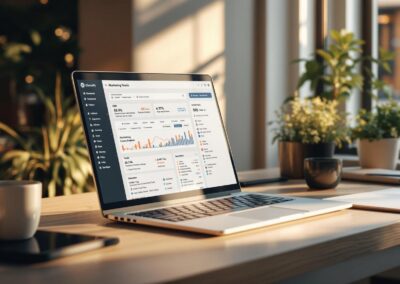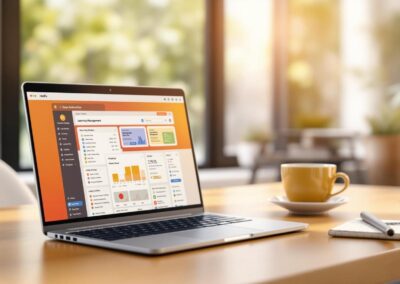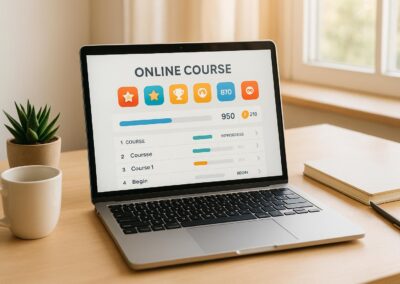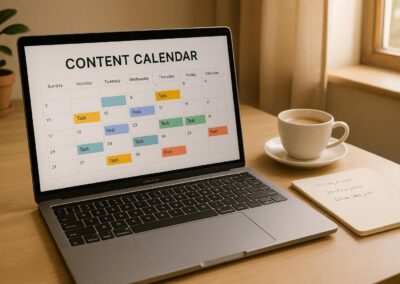Want to create a mobile LMS that works for everyone? Start by focusing on these core areas:
- Navigation Efficiency: Make it easy for users to find and access content quickly.
- Content Accessibility: Ensure materials are readable and interactive on small screens.
- Administrative Simplicity: Provide tools that let admins easily update and manage courses.
Here’s how to get it right:
- Design for small screens: Use responsive layouts, readable fonts, and tappable buttons.
- Enable offline learning: Let users download lessons and sync progress later.
- Boost engagement: Include game-like features, interactive content, and progress tracking.
- Offer customization: Personalize learning paths and make the platform accessible to all.
- Ensure speed and simplicity: Optimize load times and use clean, intuitive layouts.
A well-designed mobile LMS keeps learners engaged and admins efficient. Dive into the details to learn how to balance functionality and user-friendliness.
How To Design An Interactive Learning Management App?
Mobile Design Basics
Creating a mobile learning platform that works seamlessly across devices starts with smart design. These principles lay the groundwork for more detailed strategies.
Screen Size Optimization
A responsive design ensures content looks great on any device. Here’s how to make it happen:
- Use fonts that are easy to read on small screens
- Design buttons and interactive elements that are easy to tap
- Keep content within the screen’s width to avoid scrolling side to side
- Automatically resize images to maintain quality without slowing load times
These practices make content accessible and easy to use, no matter the device.
"Our designers are trained in functional user experience design. Simply put, we make it easy for you to add and remove content and easy for students to consume it."
Easy Touch Navigation
Touch navigation should feel natural and support one-handed use. Keep these tips in mind:
- Place key navigation buttons where they’re easy to reach
- Offer clear visual feedback for every interaction
- Use swipe gestures to move between lessons
- Space out elements to avoid accidental taps
- Position common controls in areas easily accessed by thumbs
Making navigation effortless is key, but providing offline options takes usability to the next level.
Offline Learning Options
Learners shouldn’t be limited by internet access. Here’s how to make offline learning possible:
- Cache recent lessons so they’re available without a connection
- Include a download manager for saving materials offline
- Sync progress automatically once the device reconnects
- Compress videos and images to save storage and speed up downloads
Making Mobile Learning More Engaging
Smart mobile design is just the start – keeping users motivated and involved is what truly makes mobile learning effective. By incorporating features that encourage participation and track progress, you can improve engagement and boost course completion rates.
Game Elements in Learning
Adding game-like features can make learning more enjoyable and rewarding. Use elements like badges, points, unlockable content, weekly challenges, and leaderboards to create a sense of achievement. These additions not only make the experience fun but also encourage learners to stay committed and reach their goals.
Adding Interactive Content
Interactive features encourage active participation, making the learning process more dynamic. Consider including:
- Quizzes to check knowledge after each module
- Interactive video lessons with clickable elements
- Scenario-based exercises for real-world application
- Hands-on practice assignments
- Real-time feedback to guide learners
Combining various types of interactive content keeps learners engaged and improves their overall understanding.
Along with interactive tools, showing clear progress can help maintain momentum.
Progress Tracking
Visual tools that show progress can inspire learners to keep going. Use features like progress bars, milestone markers, activity logs, performance analytics, and automated reminders. These not only motivate learners but also provide valuable insights for course creators.
Research highlights the benefits of tracking progress. For example, instructors can use this data to send personalized encouragement to learners who might be struggling or to reward high performers with certificates. This approach helps both learners and educators achieve better outcomes.
sbb-itb-dee25d2
Custom Learning Options
Customization plays a key role in shaping mobile learning experiences to suit individual needs. Mobile platforms should cater to different learning styles, ensuring users stay engaged and achieve their goals.
Personal Learning Routes
Custom learning paths allow users to move at their own pace and meet specific objectives. Here are some features that make this possible:
- Adjust content difficulty based on quiz results
- Recommend modules based on past activity
- Offer focused practice exercises
- Send tailored reminders for unfinished sections
- Provide certificates when key milestones are completed
For instance, if a learner consistently performs well on quizzes, the platform might unlock advanced content or suggest more challenging tasks to keep them motivated.
Ensuring Accessibility for Everyone
Accessibility is a key part of creating an inclusive learning environment. Features that support this include:
- Compatibility with screen readers for visually impaired users
- High-contrast display options for easier readability
- Adjustable text sizes for personalized comfort
- Closed captions for videos
- Alternative text for images and graphics
These tools ensure that all users, regardless of their needs, can access and benefit from the platform.
User Dashboards
A well-designed dashboard simplifies navigation and keeps learners informed. Useful dashboard features include:
| Feature | Purpose | Benefit |
|---|---|---|
| Progress Overview | Visual display of course completion | Quick status updates |
| Recent Activity | Record of recent learning actions | Easy course resumption |
| Upcoming Deadlines | Timeline of pending tasks | Improved time management |
| Performance Metrics | Scores and assessment results | Clear progress tracking |
| Recommended Content | Suggestions for new courses | Personalized learning path |
Dashboards should present this information clearly and efficiently. When paired with email marketing systems and CRM tools, they can send timely alerts and offer additional support, ensuring learners stay on track.
At Pro Membership Sites, these elements are the foundation of our custom WordPress-based LMS solutions, delivering a tailored and user-focused learning experience.
Speed and Ease of Use
Fast-loading content and straightforward navigation are key to keeping mobile learners engaged. A mobile LMS should offer quick access to materials with a simple, intuitive interface.
Quick Loading Content
Performance is essential for effective mobile learning. Here are some ways to reduce loading times:
- Compress images and videos to maintain quality while saving bandwidth
- Use progressive loading to display essential content immediately, with secondary elements appearing later
- Implement smart caching to store frequently accessed materials locally for faster retrieval
- Adjust content quality based on network conditions with bandwidth detection
These methods significantly improve load times and keep learners engaged. Quick delivery is the first step, but a straightforward design ensures smooth navigation.
Simple Screen Layouts
A clean and organized interface helps learners focus. Effective layout principles include:
| Design Element | Purpose | Impact |
|---|---|---|
| White Space | Reduces distractions and highlights content | Makes reading easier |
| Single-Column Layout | Avoids excessive scrolling for better usability | Simplifies navigation |
| Clear Typography | Ensures text is easy to read | Improves understanding |
| Consistent Design | Creates a familiar and cohesive experience | Eases the learning process |
A clutter-free design not only boosts readability but also reduces errors. When mistakes do happen, clear and helpful error messages are essential.
Clear Error Messages
Error messages should be easy to understand, actionable, and written in plain language. For instance, instead of a generic "Error 404", a better message might say:
"The lesson could not be found. Please refresh the page or return to your course dashboard."
These practices combine to create a smooth and supportive mobile learning experience, keeping users focused and engaged.
Connected Tools and Data
Modern mobile LMS platforms thrive on smooth integrations and effective data analysis to improve the learning process.
Connecting with Other Systems
A well-built mobile LMS should integrate effortlessly with key business tools, creating a streamlined learning environment. For instance, linking with Customer Relationship Management (CRM) systems allows for automated student tracking and personalized communication based on user activity.
| Integration Type | Purpose | Learning Benefits |
|---|---|---|
| CRM Systems | Track student behavior | Monitor progress automatically |
| Email Marketing | Send automated messages | Provide timely updates and reminders |
| Certificate Systems | Recognize achievements | Automatically award credentials |
| Analytics Tools | Measure performance | Improve courses using data insights |
These integrations form the backbone of a system that uses data to drive continuous improvements.
"With our sites, you not only can see what actions students have taken, but you can take action based on their actions as well. Send reminder emails, hook up your CRM, monitor progress, award certificates, and so much more. All built in with every membership and learning management website."
Learning from User Data
In addition to external integrations, analyzing user data can further refine and customize the learning experience. By tracking user activity and course outcomes, administrators can make smarter decisions about updates and personalization.
Using data effectively allows platforms to:
- Automate communication with learners
- Recognize achievements
- Adjust materials based on user progress
- Improve content by analyzing engagement trends
Key metrics to monitor include:
| Metric Type | What to Monitor | Actionable Steps |
|---|---|---|
| Engagement Time | How long users stay active | Adjust content length for better retention |
| Completion Rates | Percentage of modules finished | Identify and improve challenging sections |
| Navigation Patterns | How users move through courses | Simplify and refine the interface |
| Device Usage | Access trends across devices | Optimize the platform for mobile users |
Conclusion
Creating a mobile LMS that works well means blending essential design principles with features that focus on the user. A strong platform brings together easy navigation and effective tools to help both learners and administrators succeed.
To build a smooth mobile learning experience, focus on features like:
- Built-in tools for learning
- Tracking progress easily
- Integrations that work without hassle
- Options to customize for the user
The aim is to remove technical challenges so learners can concentrate on gaining knowledge. By focusing on both functionality and simplicity, these platforms make learning accessible on any device.
As mobile learning platforms grow, the key will be maintaining the right mix of advanced features and ease of use. This ensures technology supports learning instead of getting in the way.





